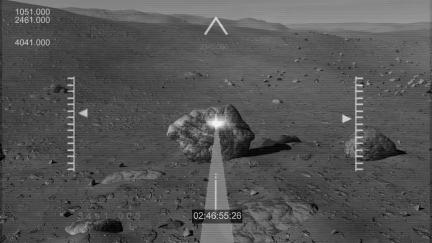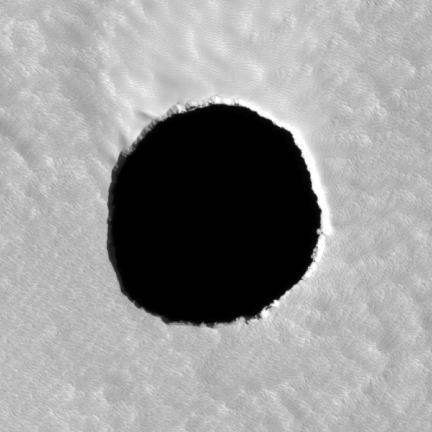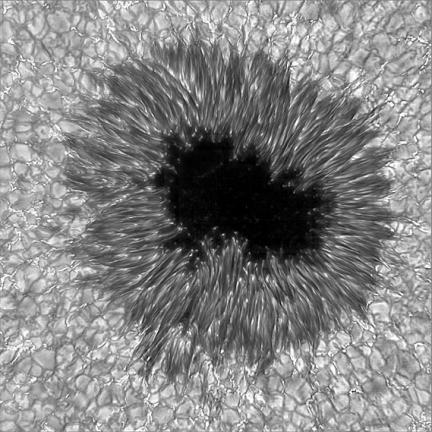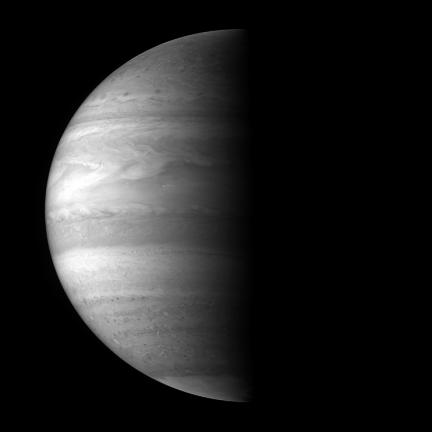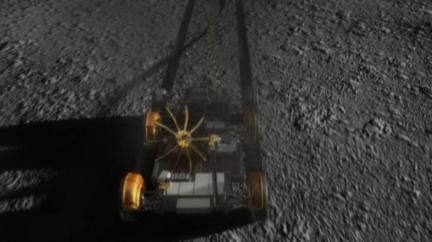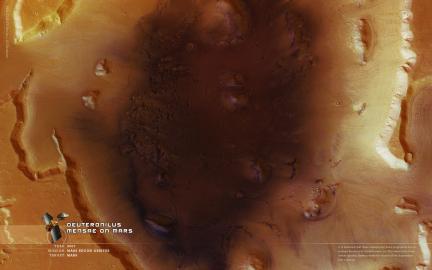 It is believed that these valleys may have originated from flash flood waters which came from melting ice many ages ago. But the conditions on Mars do not allow water to stay liquid for very long. That water would have frozen pretty quickly and then flowed down any depressions… which when you think of it - sort of makes an “instant glacier”.
It is believed that these valleys may have originated from flash flood waters which came from melting ice many ages ago. But the conditions on Mars do not allow water to stay liquid for very long. That water would have frozen pretty quickly and then flowed down any depressions… which when you think of it - sort of makes an “instant glacier”.
Telescopic Views of Our Moon and Other Planets
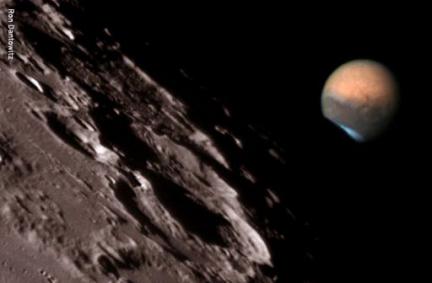
I stumbled across an image of Mars and our moon a while back, either on Universe Today or just from looking for great images of Mars on google. Anyway, it never occured to me that you can get such great detail of Mars while still being able to see a limb of the Moon in the same view. I thought it was a Photoshop job until I looked up “occult+Saturn+moon” and found similar images. For some reason, Jupiter images are more a rarity. What is unmistakable is that the above Moon/Mars image by Ron Dantowitz is pretty incredible for its clarity and detail.



I couldn’t find any of the moon and a tiny blue dot of Uranus, but you can always use your imagination.
U. Gordan just sent me one of Venus too
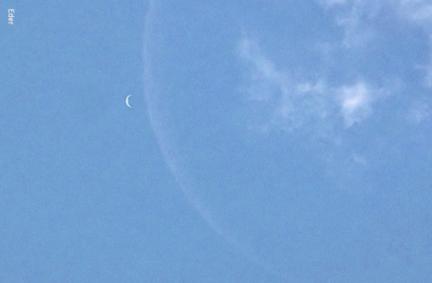
Mars Science Lab Animation
 The coming Mars Science Lab mission video is available with various resolution options here (they are also downloadble!). This animation doesn’t focus as much on the trip to Mars as the MAAS ones have in the past, I would imagine that NASA wanted to highlight all the advanced science this mission will be performing instead of focusing on the long cruise to get there.
The coming Mars Science Lab mission video is available with various resolution options here (they are also downloadble!). This animation doesn’t focus as much on the trip to Mars as the MAAS ones have in the past, I would imagine that NASA wanted to highlight all the advanced science this mission will be performing instead of focusing on the long cruise to get there.
Take a look especially at the part of the mission where apparently they actually shoot a laser beam at various targets and take measurements of, what I would imagine, are the gasses emitted from such a burn. It also illustrates the process by which MSL will be taking soil and rock samples for in-depth investigations. This mission is exactly what it claims to be… a roving Science Lab on Mars. This is as close to having astronauts on the surface as our current technology can allow… that is… without actually sending someone… which our current technology does allow.
Wallpaper: Space Walk
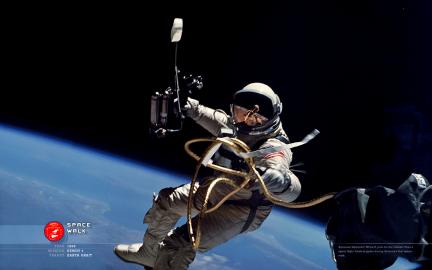 Ed White is the first American space walker, which took place on Mercury 7. Sadly, he later died on the ground in the tragic Apollo 1 flash fire which took place during a test run. The accident took the lives of 3 astronauts before Apollo even got off the ground.
Ed White is the first American space walker, which took place on Mercury 7. Sadly, he later died on the ground in the tragic Apollo 1 flash fire which took place during a test run. The accident took the lives of 3 astronauts before Apollo even got off the ground.
Note: I erroneously labeled this wallpaper as Mercury 7 and not Gemini 4. Image has been corrected.
Image Note: Some of the Earth image at the far left has been extended in Photoshop to fill out the space. The original image was square.
WTF?
I just updated this post with a higher resolution image of this hole in Mars. Click on the image for an even higher resolution version.
The darkness of this hole in Mars is not due to limitations of the cameras. The Mars Reconnaissance Orbiter is usually always able to detect details even in dark shadow. But blowing this image out to reveal details shows nothing. No side walls, no bottom… leading most to consider that this is a sinkhole that fell into a large Martian cavern. Most likely the total lack of detail probably means that the surface around this hole is actually over-hanging a deep pit.
Maybe this is where all the ancient running Martian water drained to. Better watch your step.
Io’s Tvashtar Volcano Movie in Slo-Mo

This animated gif has been making the rounds lately… It is composed of 5 images taken by New Horizons as it sped past Jupiter in February. Of course, 5 frames go by pretty quickly and do not really allow us any time to appreciate the motion. So I did a really simple thing and added a whole bunch more frames in between the 5 primary images then simply faded them into one another. This creates the illusion of a smoother and longer animation, but really you are still only seeing 5 total images. I tried faking a loop from frame 5 back to 1, but that was near impossible and not really an honest representation of what New Horizons saw.
Sharpest Image of The Sun as of 2005
Sharpest Image of The Sun as of 2002
 I have to admit this is my first direct lift right from Astronomy Picture of the Day (dating back to November 2002). Some recent images of Solar prominences and arcs are pretty close in quality if not surpass this, but I don’t think I have seen anything comparitively detailed of the actual surface like this. The image was acquired through the ground-based Swedish Solar Telescope located on the Canary Island of La Palma. Despite the ground-based operation, it still was able to make an image of the Sun that surpassed any of those taken by the observatories in orbit at that point in time.
I have to admit this is my first direct lift right from Astronomy Picture of the Day (dating back to November 2002). Some recent images of Solar prominences and arcs are pretty close in quality if not surpass this, but I don’t think I have seen anything comparitively detailed of the actual surface like this. The image was acquired through the ground-based Swedish Solar Telescope located on the Canary Island of La Palma. Despite the ground-based operation, it still was able to make an image of the Sun that surpassed any of those taken by the observatories in orbit at that point in time.
What is seen in the above image is a dark region known as a sunspot which is a planet sized area of unknown origin. 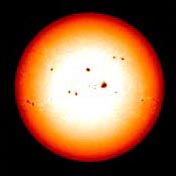 It has a much lower temperature than its surrounding areas and emits a tremendous amount of magnetic activity. Of course, any imaging the Sun in normal visible light with no photographic trickery would result in an entirely white image with no details at all. So the funny thing about these “dark spots” (see visible/white light image at left) is that they are actually blindingly bright to a human eye. It is only when we image these areas in comparitive contrast with the surrounding hotter areas do they appear as dark in photographs. These mysterious spots seem to also appear in abundance in 11 year cycles which also eludes any scientific explanation.
It has a much lower temperature than its surrounding areas and emits a tremendous amount of magnetic activity. Of course, any imaging the Sun in normal visible light with no photographic trickery would result in an entirely white image with no details at all. So the funny thing about these “dark spots” (see visible/white light image at left) is that they are actually blindingly bright to a human eye. It is only when we image these areas in comparitive contrast with the surrounding hotter areas do they appear as dark in photographs. These mysterious spots seem to also appear in abundance in 11 year cycles which also eludes any scientific explanation.
Asteroid Surface Images
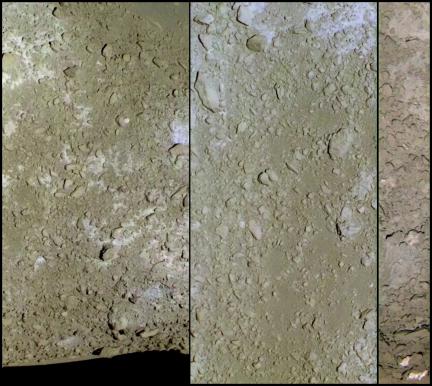 Itokawa (full name 25143 Itokawa) is an Earth crossing type asteroid that was visited by JAXA (Japan Aerospace Exploration Agency) in 2005. It was, and still may be, the first asteroid to be sampled and returned to Earth. To make a long story short, JAXA attempted quite a complicated mission for such a young agency and sent a probe to Itokawa. The plan was for Hayabusa to orbit, land upon, sample a bit of the surface and then return those samples back to Earth for retrieval. Currently, the mission is seriously damaged and operating on 1 of 3 reaction wheels. Additionally, Hayabusa suffered a major solar flare that damaged several battery cells, a rehearsal landing failed, the agency is unsure if any samples actually made it into the return cannister and 2 probes designed to study the surface also failed. Despite all this trouble and serious concern about its ability to even make it back to Earth… in early 2007 Hayabusa began its long questionable trip back home. Should it make it, the sample return cannister should re-enter Earth atmosphere in 2010.
Itokawa (full name 25143 Itokawa) is an Earth crossing type asteroid that was visited by JAXA (Japan Aerospace Exploration Agency) in 2005. It was, and still may be, the first asteroid to be sampled and returned to Earth. To make a long story short, JAXA attempted quite a complicated mission for such a young agency and sent a probe to Itokawa. The plan was for Hayabusa to orbit, land upon, sample a bit of the surface and then return those samples back to Earth for retrieval. Currently, the mission is seriously damaged and operating on 1 of 3 reaction wheels. Additionally, Hayabusa suffered a major solar flare that damaged several battery cells, a rehearsal landing failed, the agency is unsure if any samples actually made it into the return cannister and 2 probes designed to study the surface also failed. Despite all this trouble and serious concern about its ability to even make it back to Earth… in early 2007 Hayabusa began its long questionable trip back home. Should it make it, the sample return cannister should re-enter Earth atmosphere in 2010.
Never surrender!
Monster Sized Monochrome Image of Jupiter
For full resolution monster sized image click here.
Wallpaper: Phoebe Portrait
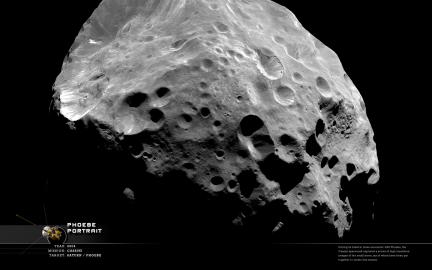 A few posts back I uploaded a closer detail of this same image. This is the best “portrait” image of Phoebe available taken by Cassini on its way into the Saturn system and orbit insertion. Being so far out from the rest of the most dle scientific targets (4x as far as Iapetus), this was the only up-close visit planned to the tiny moon who’s size is about 220km average width.
A few posts back I uploaded a closer detail of this same image. This is the best “portrait” image of Phoebe available taken by Cassini on its way into the Saturn system and orbit insertion. Being so far out from the rest of the most dle scientific targets (4x as far as Iapetus), this was the only up-close visit planned to the tiny moon who’s size is about 220km average width.
Io Plume and Europa Rises
Wallpaper: Phoebe
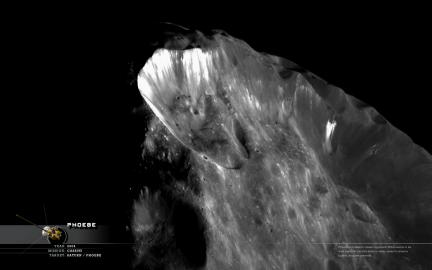 There appears to be a layer of dark material covering the small moon Phoebe as revealed by the collapse of materials in the northern region of the small moon. Phoebe orbits Saturn outside the orbit of Iapetus and has been considered a possible candidate for the dark material also found covering one side of that unusual moon. What may have caused this transfer of materials is still a mystery… or that Phoebe had anything to do with that feature on Iapetus is still very much in question.
There appears to be a layer of dark material covering the small moon Phoebe as revealed by the collapse of materials in the northern region of the small moon. Phoebe orbits Saturn outside the orbit of Iapetus and has been considered a possible candidate for the dark material also found covering one side of that unusual moon. What may have caused this transfer of materials is still a mystery… or that Phoebe had anything to do with that feature on Iapetus is still very much in question.
Some propose that Phoebe is actually a captured comet from the Kuiper belt (a region of small bodies orbiting the sun beyond Neptune of which Pluto is considered a member). If this is true, the images taken by cassini would be the only images of such bodies to be anything other than a single point of light.
Dione: A Quick Composite
I noticed some recent images taken of Dione would make a nice hires if one were to stitch them together. Of course, these images were each (4 of them) taken at different times and therefore, the cassini spacecraft was at different vantage points (see the original 4 images below).

So matching them up is not quite as simple as lining up a few repeat details from one to the next, but photoshop gives one some powers of distortion to make up for some of that. The biggest issue was the disc edges – for when they didn’t match up (and they didn’t) all there was for me to do was to draw a circle and erase. I cannot match the technical skills of some of the freelance imagers that I have featured on the right, but its fun making myself a nice large scale image of one of Saturn’s larger moons.
Stardust Extended Mission Target Is…
Soon after the Stardust mission flew in close and collected tiny samples of comet dust in Jan 2004 from the comet Wild 2, the spacecraft was placed into hibernation mode – only to be awakened for occasional health status calls.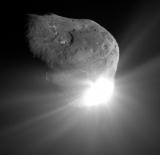 A proposal to extend the mission into Stardust-NExT suggests the spacecraft be sent on a trajectory to encounter comet Tempel 1. The main objective of this mission would be to image the crater left behind by the Deep Impact mission of 2005. That mission did not manage to image the resulting crater due to the huge amount of dust blasted off from the impact (pictured above-left) which blocked the view until well after DI’s cameras were out of range to see any details on its surface. The final decision on this extended mission is expected this May/June and should it be approved… it is expected that Stardust-NExT would reach Tempel 1 at some point around 2010.
A proposal to extend the mission into Stardust-NExT suggests the spacecraft be sent on a trajectory to encounter comet Tempel 1. The main objective of this mission would be to image the crater left behind by the Deep Impact mission of 2005. That mission did not manage to image the resulting crater due to the huge amount of dust blasted off from the impact (pictured above-left) which blocked the view until well after DI’s cameras were out of range to see any details on its surface. The final decision on this extended mission is expected this May/June and should it be approved… it is expected that Stardust-NExT would reach Tempel 1 at some point around 2010.
Return to the Moon Trailer
NASA has put out a “Return to the Moon” trailer at anon.nasa-global.edgesuite.net
Wallpaper: Southern Saturn
 According to the Cassini website, this image was taken at about 58 degrees below the ring-plane in the southern hemisphere. The southern lower half of Saturn tends to appear yellow-peach while (at current) the northern half of Saturn leans to a white-grey-blue, with varying effects from the shadows of the rings cast upon the cloud tops (just visible on the middle-left). It is unusual to view such a large area of Saturn’s globe without the intrusion of rings or ring-shadows and it reminds us how gorgeous Saturn would be even without its stunning rings.
According to the Cassini website, this image was taken at about 58 degrees below the ring-plane in the southern hemisphere. The southern lower half of Saturn tends to appear yellow-peach while (at current) the northern half of Saturn leans to a white-grey-blue, with varying effects from the shadows of the rings cast upon the cloud tops (just visible on the middle-left). It is unusual to view such a large area of Saturn’s globe without the intrusion of rings or ring-shadows and it reminds us how gorgeous Saturn would be even without its stunning rings.
Wallpaper: Ganymede Up Close
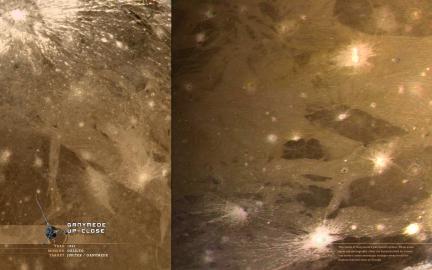 Two views of Ganymede’s patchwork surface taken by Galileo around 1997. While some areas appear geologically older (as demonstrated by the record of impact cratering) some seemingly younger areas recall the fracturous features seen at Europa. Many theorize, just as they do at Europa, that there may be a global ocean of water beneath the surface at Ganymede. However, it is also assumed (if if this does exist) that this ocean would be more shallow and under a much thicker crust of rock hard ice than that of Europa.
Two views of Ganymede’s patchwork surface taken by Galileo around 1997. While some areas appear geologically older (as demonstrated by the record of impact cratering) some seemingly younger areas recall the fracturous features seen at Europa. Many theorize, just as they do at Europa, that there may be a global ocean of water beneath the surface at Ganymede. However, it is also assumed (if if this does exist) that this ocean would be more shallow and under a much thicker crust of rock hard ice than that of Europa.
Wallpaper: Geysers on Enceladus
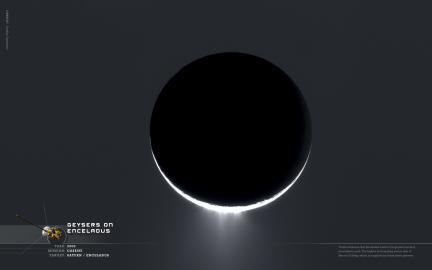 Visual evidence that Enceladus hosts cryo-geysers around its southern pole. The lighter surrounding area is due to Saturn’s E-ring, whose materials are supplied by these same geysers.
Visual evidence that Enceladus hosts cryo-geysers around its southern pole. The lighter surrounding area is due to Saturn’s E-ring, whose materials are supplied by these same geysers.
This is another image supplied by Mr. Gordan Ugarkovic who notes that “this is a colorized image, artificial color was added to make the plumes and E ring subtly bluish, while saturnlit portion of Enceladus slightly brownish. In reality no color frames were taken, only clear filter ones”.
Completely Unrelated: chopshopstore.com
My full time company (unrelated to space interests) has launched its “shop” and is sporting a bunch of tees and designs aimed at computer nerds, designers, illustrators and nerds in general. While I don’t have any directly space related designs up there (yet), there is a poster we did for an event I spoke at does feature me as a robot surrounded by a few moons. You may even recognize one as slightly Mimas looking and the other a bit Europan. The other two are just your generic cratered looking ice balls.
